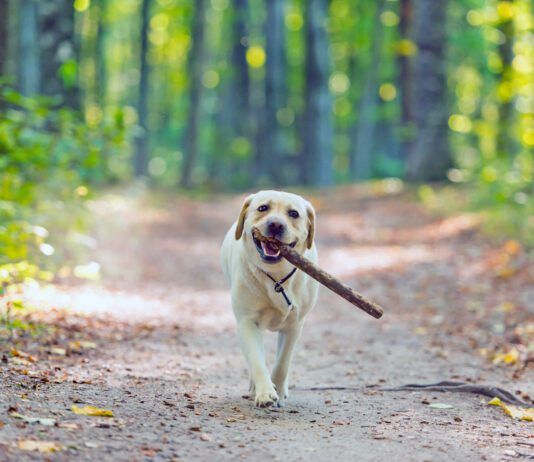(Collars & Leashes #1) – Finding The Best Equipment
A roomful of dog trainers will never agree on the best equipment for walking, training, or exercising a dog. How do you decide which training equipment is right for you and your dog? First, understand that you, alone, are responsible for choosing appropriate, humane, effective training equipment for your dog - not Whole Dog Journal, your trainer, spouse, your dog’s breeder, or acquaintances from the dog park.
(Managing Your Dog’s Weight #1) – Understanding Fat and Its Part in Your...
Fat has more than twice the calories per gram of protein or carbs, so the amount you feed should be limited. Fat, however, is also what satisfies the appetite best. A diet that is too low in fat will leave your dog feeling hungry all the time, making it harder for you to stick to the diet plan and potentially leading to food-stealing or even poop-eating. It’s better to feed a diet with moderate fat and reduce the portion size as needed rather than feeding a low-fat diet.
(Homemade Cooked Diets for Dogs #2) Homemade Cooked Diets for Dogs
While meals can be prepared individually, you may find it easier to cook up large batches at one time, and then divide the food into meal-sized portions and freeze. Because variety is important over time and not necessary at every meal, you can feed the same foods for a week or two, and then switch to something else when you make the next batch.
(Crate Training Made Easy #3) – Crate Usage for Your Dog
A crate, or, in other words, short-term close confinement, can be used to help dogs teach themselves two very important skills. The first is eliminating only when and where it is appropriate. The second skill is keeping out of trouble – behaving appropriately in the house. Without these two skills, a dog doesn’t have much of a chance in this world.
(Positive Training Basics #3) Keeping Dog Training Fun and Playful
When rewarding your dog, don’t confuse your fun with the dog’s fun. Most dogs love to be petted, but not in every context and not in all ways. Most people like petting their dogs, but some don’t notice that their dogs don’t like being pat-patted on top of the head as reinforcement for coming when called.
(Approaches to Modifying Dog Aggression #1) Approaches to Modifying Dog Aggression -Tip #1
Many dogs who behave aggressively toward other dogs do so as a result of learning that their barking, growling fit results in the other dog going away. Because that behavior has been successful in the past, it’s been reinforced, and the behavior has continued or increased.
Positive Training Methods That Work – Advice on Positive Dog Training
Old-fashioned training methods can work. Decades of well-behaved dogs and the owners who loved them can attest to that. So why should they bother to cross over to the positive side? The short answer is that positive training works, it’s fun, and it does not have the potential to cause stress and physical injury to our dogs through the application of force, pain, and intimidation. It takes the blame away from the dog and puts the responsibility for success where it belongs on human shoulders.
(Home-Prepared Raw Dog Food Diets #2) The Benefits to a Raw Diet
Preparing your dog’s meals yourself is not as easy as simply opening a can or pouring kibble out of a bag. However, once you’ve done the initial work of devising the diet and finding sources for the products you will feed, it isn’t terribly time-consuming. The actual preparation is fairly simple; the hardest part is buying products in bulk and then splitting them up into meal-sized portions for feeding. But the rewards can make it all worthwhile.
Understanding The Triggers of Canine Separation Anxiety
Have you ever had the misfortune of walking into your house to find overturned furniture, inches-deep claw gouges on door frames, blood-stained tooth marks on window sills, and countless messages on your answering machine from neighbors complaining about your dog barking and howling for hours on end in your absence? If so, you’re probably familiar with the term “separation anxiety” - a mild label for a devastating and destructive behavior.
(Crate Training Made Easy Tip #1) Crate Training Made Easy
A crate, or, in other words, short-term close confinement, can be used to help dogs teach themselves two very important skills. The first is eliminating only when and where it is appropriate. The second skill is keeping out of trouble – behaving appropriately in the house. Without these two skills, a dog doesn’t have much of a chance in this world.
(The Finer Points to Home-Prepared Diets #1) – The Finer Points to Home-Prepared Diets...
Liver is one of the most nutrient-dense foods you can feed, providing not only vitamin A, but also all the B vitamins, choline and inositol, vitamins D, E, and K, and the minerals iron, zinc, copper, manganese, selenium, and potassium, as well as essential fatty acids and high-quality protein. Don’t skimp on this nutritious food due to an unreasonable fear of too much vitamin A. Around five percent of the total diet should be liver, if possible.
(Positive Training Basics #1) Advice on Positive Dog Training
Positive does not mean permissive. We just have different ideas about the necessary nature of the negative consequence. When one is needed, positive trainers are most likely to use “negative punishment” (taking away a good thing), rather than “positive punishment” (the application of a bad thing). As an adjunct to that, we counsel the generous use of management to prevent the dog from practicing (and getting rewarded for) undesirable behaviors.





